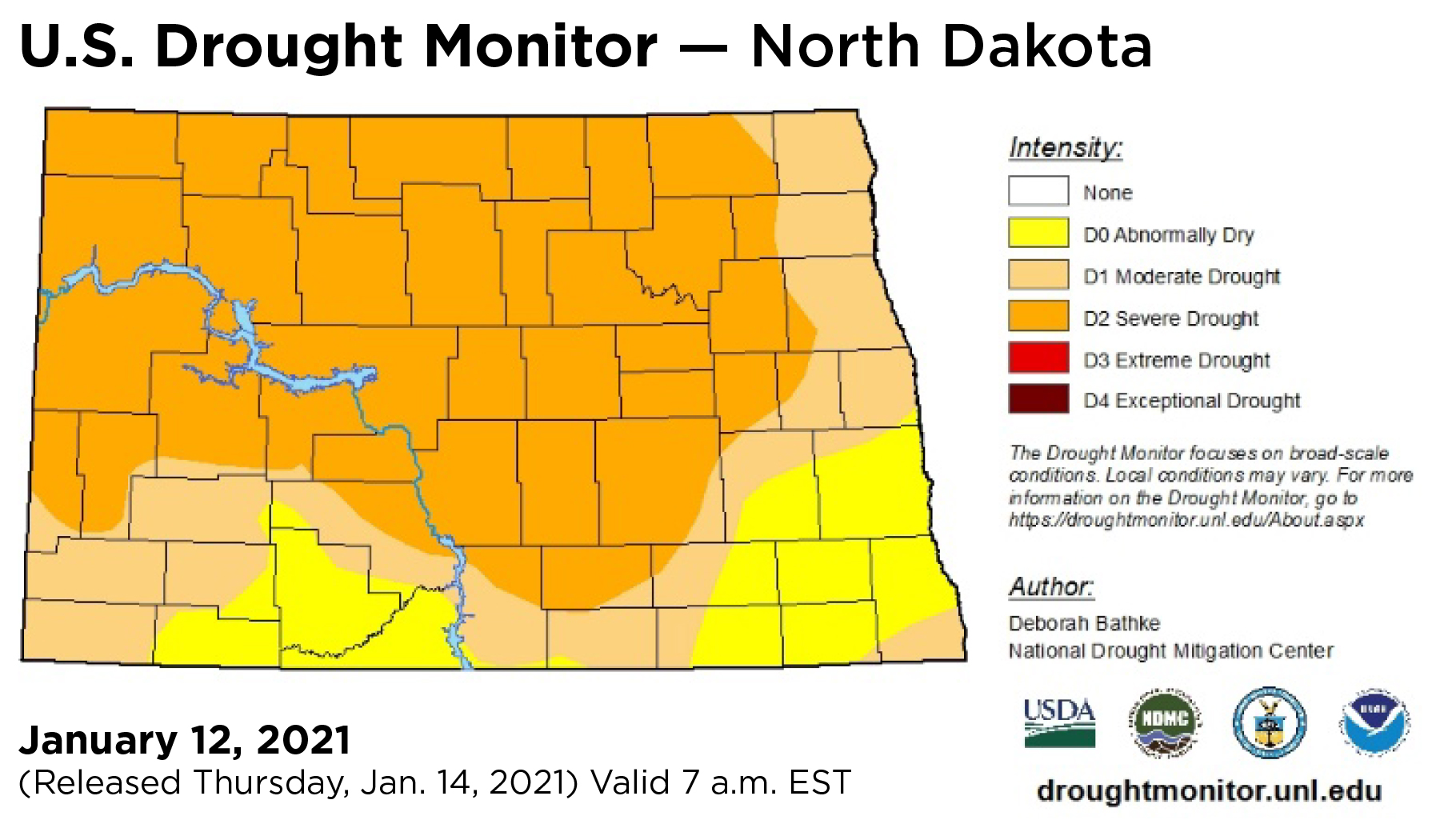Producers Should Be Prepared for Drought
Continuing drought conditions will have an impact on forage production.

This Drought Monitor map shows the latest drought conditions in North Dakota.
North Dakota producers need to be prepared in case drought conditions persist into 2021, according to North Dakota State University Extension specialists.
Most of the Dakotas, northern Minnesota and eastern Montana suffered from some level of drought in 2020. As of Jan. 14, 2021, all of North Dakota was impacted by dry conditions, with 23% of the state in moderate and 62% of the state in severe drought.
The 2020 drought affected forage production on pastureland and hay land.
“Depending on your grazing management practices, many pastures would have gone into the winter stressed, leaving plants vulnerable to death of new tillers, thus leading to slow and delayed growth this coming spring,” warns Kevin Sedivec, NDSU Extension rangeland management specialist.
North Dakota went into the fall of 2020 with precipitation in most of the state at 35% to 150% below normal. Thus, the 2021 growing season will start with very little moisture in the topsoil and little to no subsoil moisture.
“If the drought extends into the 2021 growing season, expect a severe loss in forage production,” Sedivec says. “We recommend that ranchers and farmers put together a drought management plan early so they are prepared if drought persists.”
Seventy to 80% of forage production on pasture and hay land occurs by July 1 in the northern Plains, so if the spring and early summer are dry, producers could see a 50% or greater reduction in forage produced, depending on the severity of drought and past management.
“The only silver lining is drought-stressed grasses abort seed production, so forage quality should be greater longer into the grazing season,” says Miranda Meehan, NDSU Extension livestock environmental stewardship specialist. “If summer moisture does occur and plants remain immature, regrowth potential will be greater and nutritional quality higher later into the grazing season.”
Even with normal spring precipitation, producers should expect a reduction in forage production due to plant stress and delayed spring growth, the specialists caution. With normal precipitation, shallow-rooted plants will benefit while deep-rooted plants will suffer due to lack of subsoil moisture.
“Under this scenario, plan for a 10% to 30% reduction in forage, depending if you overgrazed, properly grazed or undergrazed your pastures,” Meehan says. “Severely grazed pastures may even experience greater than 30% reduction under normal spring precipitation conditions.”
A wet spring will lead to a best-case scenario. Usually, wet springs result in above-normal forage production. However, with no subsoil moisture, forage production still may be below normal if pastures were overgrazed in 2020.
“A wet spring should alleviate the need to implement a drought plan,” Sedivec says. “However, you still need to plan for delayed growth due to drought-stressed plants. Delayed growth would result in a delayed pasture turnout by one to two weeks.
“Be prepared to implement your drought management plan if the summer growing period becomes dry,” he adds. “Wet springs followed by droughts lead to poor-quality feed during the second half of the grazing season.”
For more information on coping with drought conditions, check out the NDSU Extension publication “Strategies for Managing Drought in the Northern Plains” at http://tinyurl.com/DroughtManagementStrategies.
NDSU Agriculture Communication -Jan. 15, 2021
Source: Kevin Sedivec, 701-424-3606, kevin.sedivec@ndsu.edu
Source: Miranda Meehan, 701-231-7683, miranda.meehan@ndsu.edu
Editor: Ellen Crawford, 701-231-5391, ellen.crawford@ndsu.edu
